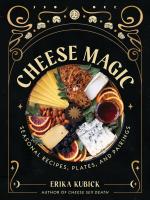Take a Sensory Journey Through the Wheel of the Year with Cheese Magic
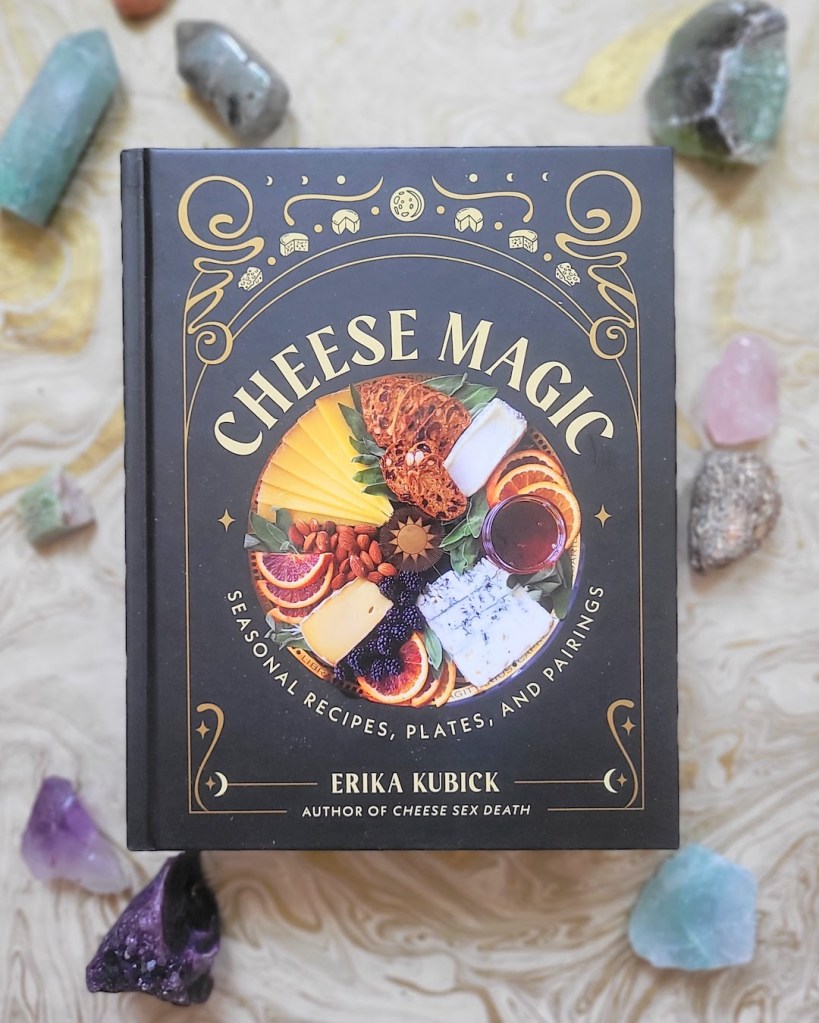
“What is a cheese plate if not an altar?” Professional cheesemonger and devoted cheese priestess Erika Kubick asks this question in the introduction to her book Cheese Magic: Seasonal Recipes, Plates, and Pairings. This culinary grimoire invites us to observe the Wheel of the Year (or more simply, the changing seasons) through ingredients that anchor us to our environments, and to our own inner cycles. Erika offers eight recipes, three cheese plates, and two pairings for each Sabbat – thirteen opportunities to observe the current season.
Read on for recipes to honor four of the eight sabbats of the Wheel of the Year: a Cheese-Stuffed Pumpkin for Samhain (All Hallows’ Eve), Bejeweled White Chocolate Bark with Goat Gouda for Yule (the Winter Solstice), Blue Cheese Deviled Eggs for Ostara (the Spring Equinox), and a Grilled Zucchini Salad with Lime, Cilantro, and Cotija for Litha (the Summer Solstice).
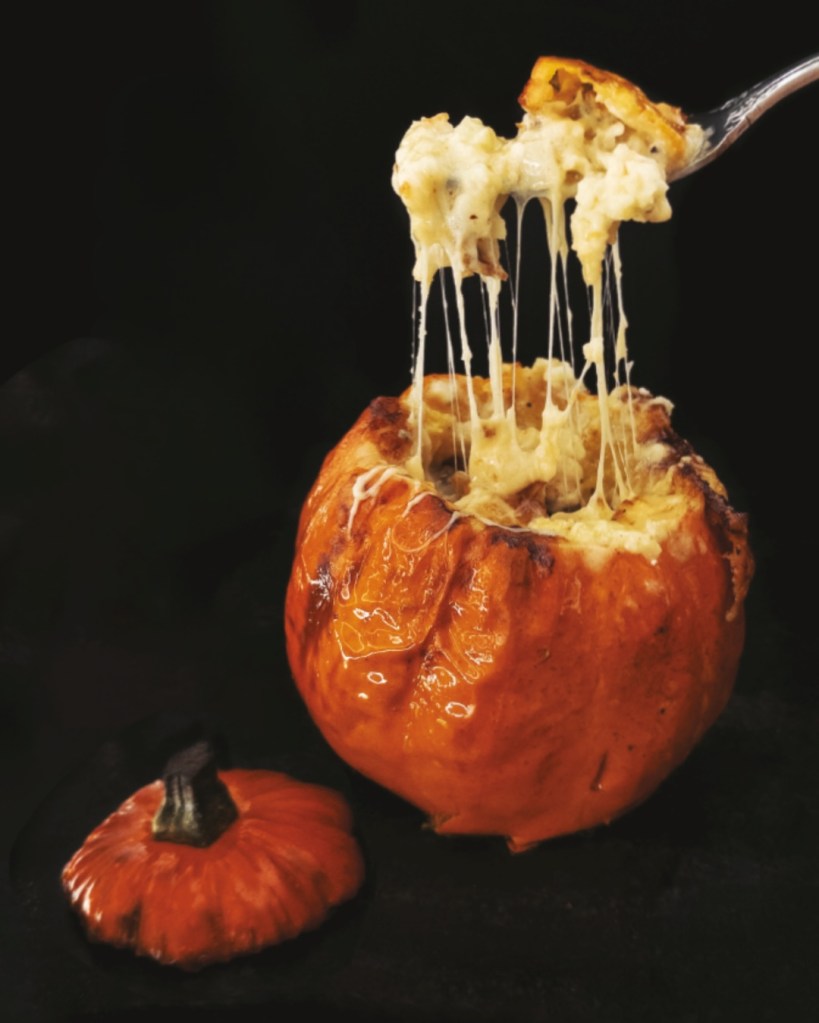
Cheese-Stuffed Pumpkin
Serves 2 to 4
Stuffed with sweet, nutty Comte, cream, broth, and a little toasted bread, the sultry squash is roasted until the flesh caramelizes and the brew within bubbles with hot, cheesy decadence. I recommend using a sugar pumpkin, but you can also use acorn or red kuri squash. Just make sure to slice a little bit off the bottom so it sits flat. Pair with a dark, malty ale or Pomegranate Tonic (recipe shared in the book).
Ingredients:
• 2 slices sourdough, 1 inch (2.5 cm) thick
• 1½-pound (225 g) pumpkin or similar squash
• 1½ teaspoons neutral oil
• Salt and freshly ground black pepper
• ½ cup (120 ml) vegetable or chicken broth
• ¼ cup (60 ml) heavy whipping cream
• 2 garlic cloves, minced
• 1 teaspoon chopped fresh sage
• ¼ teaspoon nutmeg
• 6 ounces (170 g) Comté or other Alpine-style cheese, at room temperature, freshly shredded
- Preheat the oven to 450°F (230°C). Line a baking sheet with aluminum foil or a silicone mat.
- Cut or tear the sourdough into cubes. Lightly toast them on the baking sheet until golden. Let cool completely. Set aside.
- Slice the top off the pumpkin and scoop out all the strings and seeds. Place the pumpkin on the baking sheet and rub with the oil. Coat the inside, outside, and top lid. Sprinkle the inner cavity with a pinch each of salt and pepper. In a liquid measuring cup, whisk together the broth, cream, garlic, sage, and nutmeg.
- Place a third of the bread cubes inside the pumpkin. Pour a third of the broth mixture on top, then add a handful of cheese. Repeat until you reach the top. Finish with the rest of the cheese and a little black pepper.
- Place the top lid next to the pumpkin to roast alongside. Bake until fork-tender, about 40 to 45 minutes. Let cool for 5 minutes.
- Transfer the pumpkin to a serving platter and put the top back on for presentation. Scoop the fondue onto plates, making sure to get some of the cheese mixture and some of the soft pumpkin flesh too.
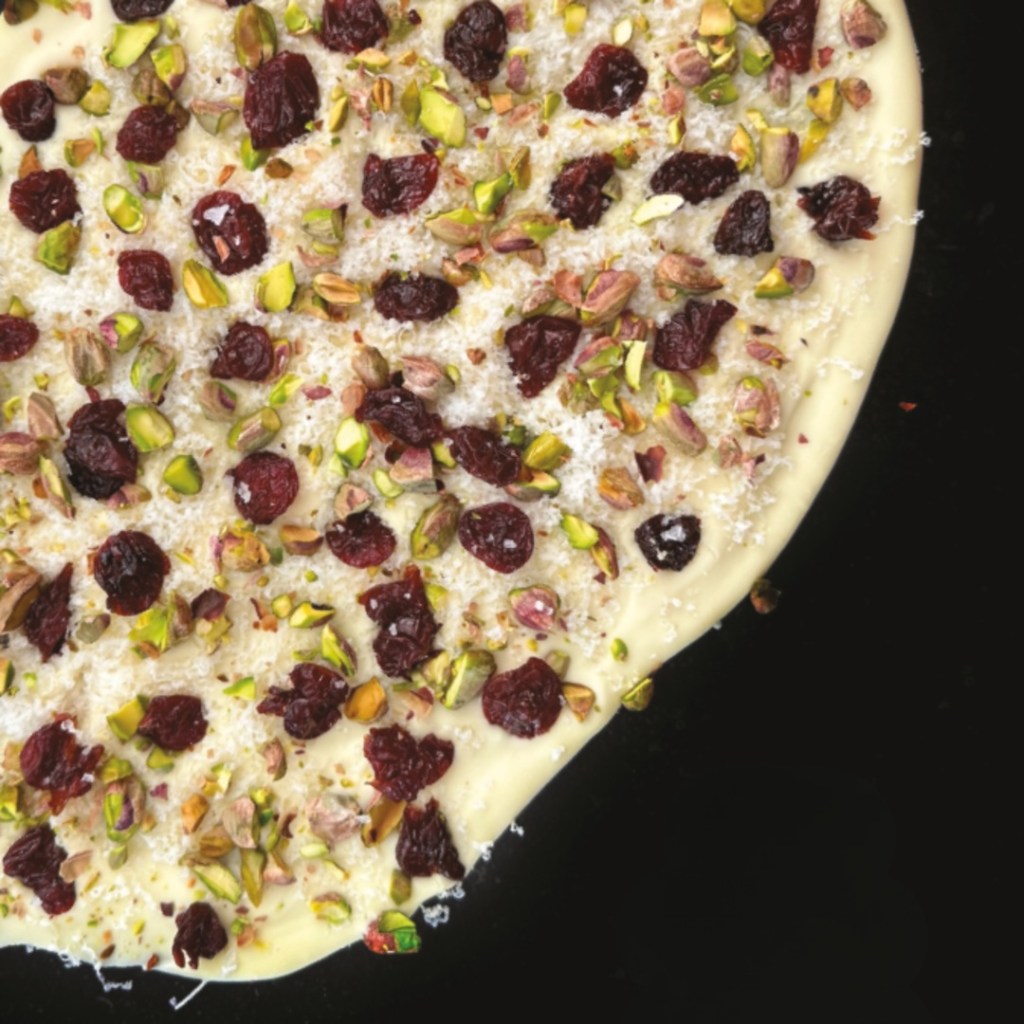
Bejeweled White Chocolate Bark with Goat Gouda
Serves 6 to 8
Chocolate bark is easy and versatile, making it an ideal conduit for rituals. You can infuse the chocolate with intentions as you melt it, carve the bark with sigils, or decorate it with any assortment of dried fruits and nuts to suit your preferences and spellwork. This recipe is loosely based on one from my favorite kitchen deity, Ina Garten, and inspired by a goat Gouda bark I tried at All Together Now, a local wine and cheese shop in my hometown of Chicago. A snowy shower of goat Gouda brings tang to the white chocolate and complements the nuts and fruit. Feel free to sub out the cheese as long as it’s hard and easy to grate.
Ingredients:
• 8 ounces (230 g) high-quality white chocolate, roughly chopped
• 1 ounce (28 g) goat Gouda
• ¼ cup (25 g) roasted and salted
• pistachios, roughly chopped
• ¼ cup (40 g) dried cherries
• ½ teaspoon flaky salt
- Add ¾ of the white chocolate to a heatproof glass bowl and microwave for 20 seconds. Stir well with a rubber spatula, and microwave another 20 seconds. Repeat, heating in 10 second intervals, until melted. Add the rest of the chocolate, and stir until completely smooth.
- Line a sheet pan with parchment paper. Pour the chocolateover the paper, using a rubber spatula to spread it evenly, leaving a 2-inch (5-cm) border.
- Using a microplane, grate the Gouda over the chocolate. It should resemble freshly fallen snow.
- Decorate the bark with the pistachios and dried cherries. Gently press the toppings into the bark so they stick. Finish with a light sprinkling of the salt.
- Let cool for about an hour, then break into shards and serve.
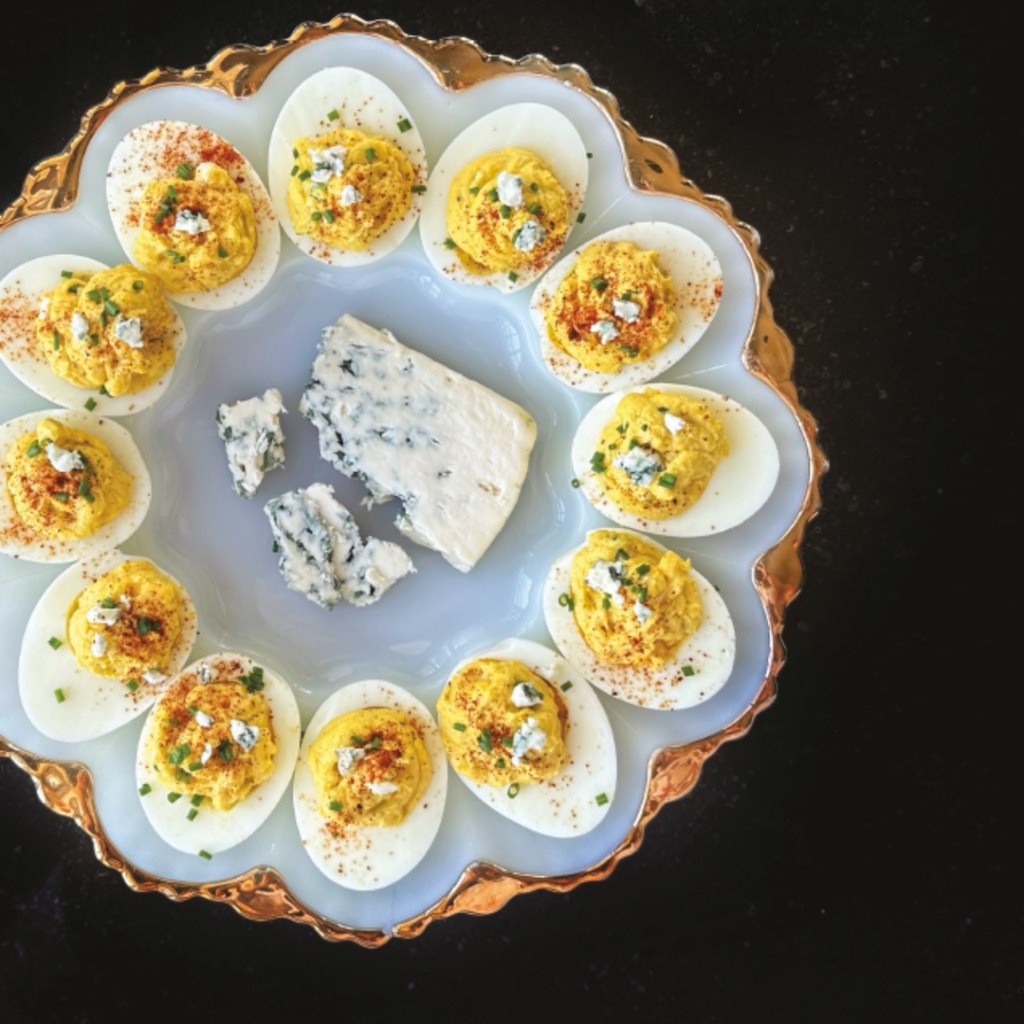
Blue Cheese Deviled Eggs
Makes 2 dozen devils
Eggs are perhaps the quintessential food of Ostara because they represent new life. As spring breaks through winter’s shell, nature seems to hatch all around us. Even the yolks themselves are symbols of the sun. I love the ritual of making deviled eggs: cooking them until their insides solidify, peeling away their shells, and gently removing the yolks so I can mash them with fats and flavorings before returning them to their silky white beds. I recommend steaming the eggs rather than boiling them, which makes them easier to peel. The secret to perfect deviled eggs is butter and mayo, a trick I learned from Julia Child’s recipe. My version is spiked with fiery horseradish, chives, paprika, and creamy blue cheese, which add a special piquancy. That extra heat is essential because the “devil” refers to the spicy flavors, which are evocative of hellfire. Serve on the Ostara Brunch Plate or the Afternoon Tea Plate (recipes shared in the book).
Ingredients:
• 1 dozen large eggs
• ½ cup (115 g) mayo, at room temperature
• 2 tablespoons unsalted butter, at room temperature
• 2 teaspoons horseradish
• 2 tablespoons chives chopped, plus an extra teaspoon for garnish
• 3 ounces (85 g) creamy blue cheese, plus an extra ounce for garnish
• Kosher salt and freshly ground black pepper
• Paprika, to garnish
- Steam the eggs: Fill a pot with enough water to reach the bottom of a steam basket. Place the basket inside the pot and bring the water to a boil.
- Place the eggs in a single layer at the bottom of the basket. Set a timer for 15 minutes. While the eggs are cooking, set up an ice bath: fill a large bowl halfway with ice and then fill the rest of the bowl with cold water.
- Once the eggs are cooked, transfer them to the ice bath and let chill for 10 minutes.
- Carefully peel the eggs, then cut each in half. Scoop the yolks into a medium mixing bowl and set the whites aside.
- To the bowl with the yolks, add the mayo, butter, horseradish, and chives and mash with a fork until smooth.
- Crumble the blue cheese into a small bowl, and microwave at 5-second intervals until the cheese is softened. Let cool for a minute.
- Add the blue cheese to the yolk mixture and continue mashing until smooth. Taste and season with the salt and pepper.
- Scoop the yolk mixture into a pastry bag or plastic bag, and cut a ¼ inch off of the corner.
- Sprinkle the egg whites with a pinch of salt. Fill with the yolk mixture just before serving.
- Garnish with a sprinkle of paprika, chives, and a touch of crumbled blue cheese.
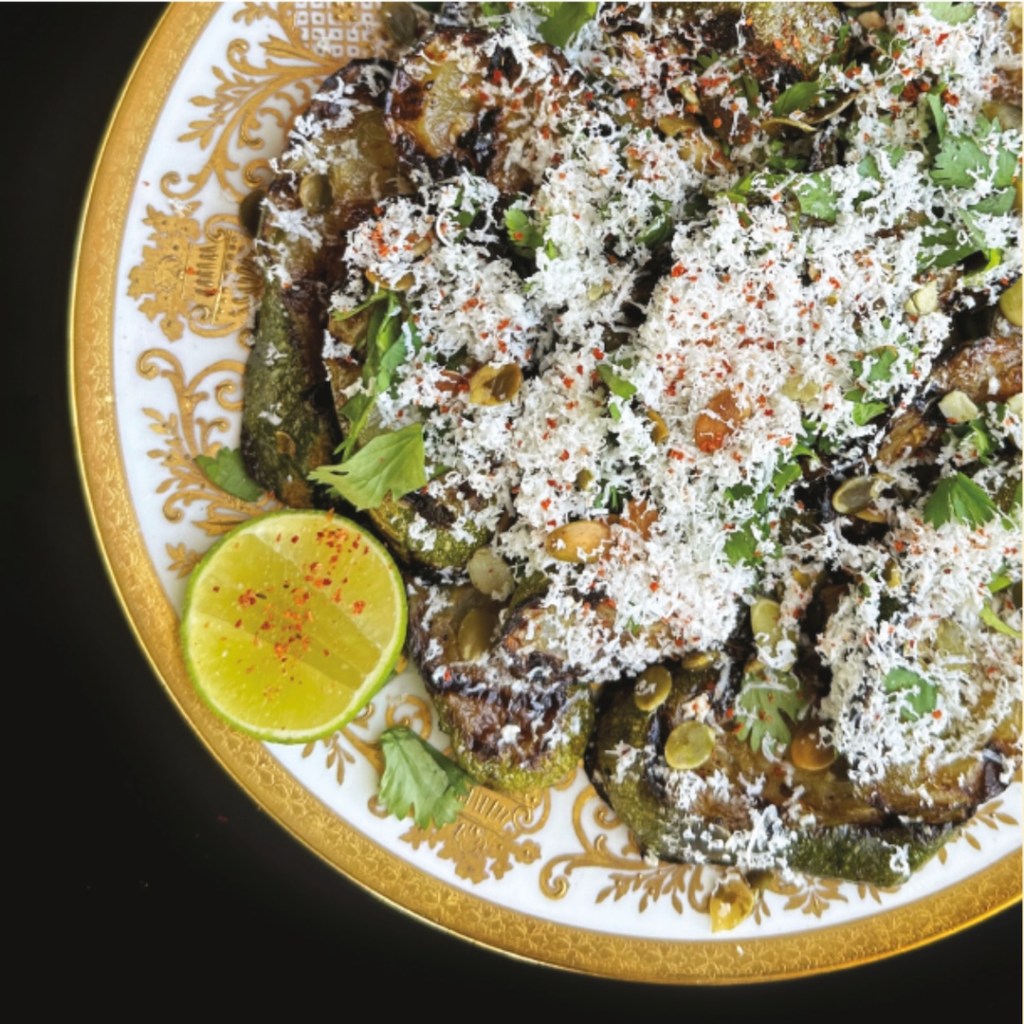
Grilled Zucchini Salad with Lime, Cilantro, and Cotija
Serves 4
Zucchini is native to Mexico, dating back to at least 5500 BC, and this salad honors that heritage with Cotija. Named after the town of the same name in the Michoacán region, Cotija has a salty, milky flavor and crumbly texture that makes it a popular topping for grilled dishes like elote. Here, it tops grilled zucchini planks, finished with lime juice and a little Tajin for heat. It’s a simple salad, but with the amount of zucchini that’s to come throughout the harvest season, you need something easy. Pair with a light beer or the Solstice Sun Tea (recipe shared in the book).
Ingredients:
• 2 pounds (910 g) zucchini, washed and dried
• 2 teaspoons Diamond Crystal kosher salt, divided
• 2 tablespoons olive oil
• ¼ cup (16 g) chopped fresh cilantro
• 1½ tablespoons toasted pepitas
• ½ lime
• 2 ounces (55 g) Cotija Añejo
• Tajin, to finish
- Cut the zucchini lengthwise into ¼-inch (6-cm) slices. Lay out on a baking sheet, sprinkle with 1 teaspoon of the salt, and let sit for 10 minutes. Use a paper towel to wipe off the salt and moisture.
- Flip the zucchini and repeat on the other side.
- Add the zucchini to a large bowl, then add the olive oil. Toss to coat.
- Heat the grill to medium-high heat, about 400°F (200°C). Spread out the zucchini, and grill until tender and charred, about 5 minutes on each side. Let cool for about 5 minutes.
- Spread out over a serving platter. Sprinkle with the cilantro and pepitas and squeeze the lime over it all. Grate the Cotija over, then finish with a dusting of Tajin. Serve immediately.
Dive Deeper
Explore 100 seasonal and mouthwatering recipes, plates, and pairings inspired by the festivals of the pagan Wheel of the Year. Captured in rich, eye-popping photography and accompanied by wickedly beautiful illustrations by Devin Forst, cheese becomes an edible manifestation of seasonal celebration.





